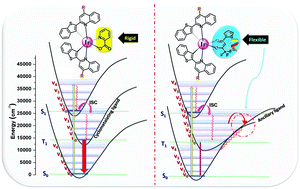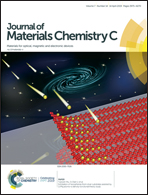Ancillary ligand-assisted robust deep-red emission in iridium(iii) complexes for solution-processable phosphorescent OLEDs†
Abstract
The possibility of future potential applications, spanning from military dark-vision displays and data undergird devices to civilian medical nosology and photobiomodulation light therapy, has created an enormous demand for the development of highly efficient, stable, flexible, and low-cost deep-red emitting luminophores. Herein, two new deep-red (650–800 nm) emissive iridium(III) complexes, Ir1-pic and Ir2-pic, have been developed, based on electron-donating –CH3 substituted and unsubstituted cyclometalating (benzo[b]thiophen-2-yl)quinoline and picolinate ancillary ligands, the structures and distorted octahedral coordination motifs of which were authenticated by single-crystal X-ray diffraction analysis. An in-depth study on the effect of the ancillary ligands on the excited-state process was carried out and the results were compared with reference compounds containing thenoyltrifluoroacetylacetonate in place of the picolinate ancillary ligand. The rigid nature and high triplet energy levels of the picolinate ancillary ligand led to a robust deep-red emission; however, the triplet spin density population and flexible nature of the β-diketonate ancillary ligand triggered an excited-state geometrical deformation, leading to the opening up of dominant, unfavorable, nonradiative pathways. Most importantly, the picolinate coordinated complexes Ir1-pic and Ir2-pic were found to exhibit excellent emission efficiencies (ΦPL = 0.48 and 0.37, respectively) and were effectively employed as deep-red dopants in organic light-emitting diodes, constructed via a solution-processed approach. The unoptimized Ir1-pic and Ir2-pic-based devices with various doping ratios were found to have maximum external quantum efficiency values of 5.03% and 3.41%, respectively.



 Please wait while we load your content...
Please wait while we load your content...